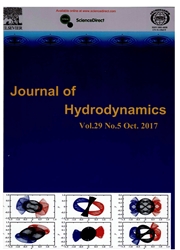

 中文摘要:
中文摘要:
The pile-soil interaction under wave loads is an extremely complex and difficult issue in engineering. In this study, a physical model test is designed based on the principle of the gravity similarity to obtain time histories of wave forces of unsteady regular waves, and to measure the magnitude and the distribution of wave forces acting on the piles. A numerical model and relevant numerical methods for the pile-soil contact surface are adopted based on the principles of elastic dynamics. For a practical project, the time histories of wave forces on the piles are obtained through physical model tests. The deformations of the piles in the pile-soil interactions and the distribution of the bending moment on the piles are studied. It is shown that, with the increase of the period of wave pressures, the absolute value of the horizontal displacement of the piles increases, the embedment depth of the piles increases, and the scope of influence of soils increases. The change of the bending moment on the piles is consistent with that of its theoretical results, and the proposed numerical method can very well simulate the properties of the piles.
 英文摘要:
英文摘要:
The pile-soil interaction under wave loads is an extremely complex and difficult issue in engineering. In this study, a physical model test is designed based on the principle of the gravity similarity to obtain time histories of wave forces of unsteady regular waves, and to measure the magnitude and the distribution of wave forces acting on the piles. A numerical model and relevant numerical methods for the pile-soil contact surface are adopted based on the principles of elastic dynamics. For a practical project, the time histories of wave forces on the piles are obtained through physical model tests. The deformations of the piles in the pile-soil interactions and the distribution of the bending moment on the piles are studied. It is shown that, with the increase of the period of wave pressures, the absolute value of the horizontal displacement of the piles increases, the embedment depth of the piles increases, and the scope of influence of soils increases. The change of the bending moment on the piles is consistent with that of its theoretical results, and the proposed numerical method can very well simulate the properties of the piles.
 同期刊论文项目
同期刊论文项目
 同项目期刊论文
同项目期刊论文
 Comprehensive assessment and global stabilisation measures of a large landslide in hydropower engine
Comprehensive assessment and global stabilisation measures of a large landslide in hydropower engine Deformation and control engineering related to huge landslide on left bank of Xiluodu reservoir, sou
Deformation and control engineering related to huge landslide on left bank of Xiluodu reservoir, sou 期刊信息
期刊信息
